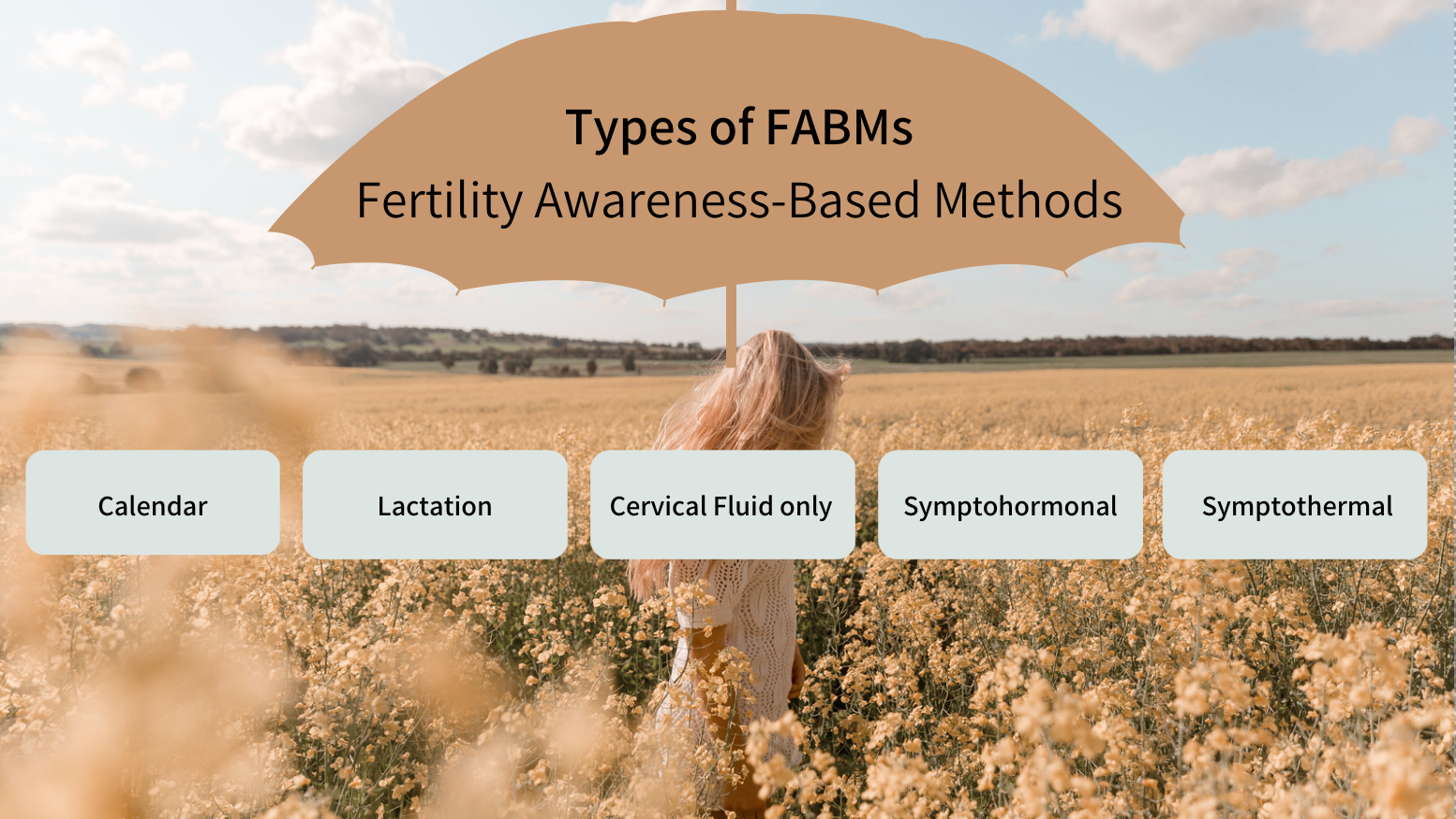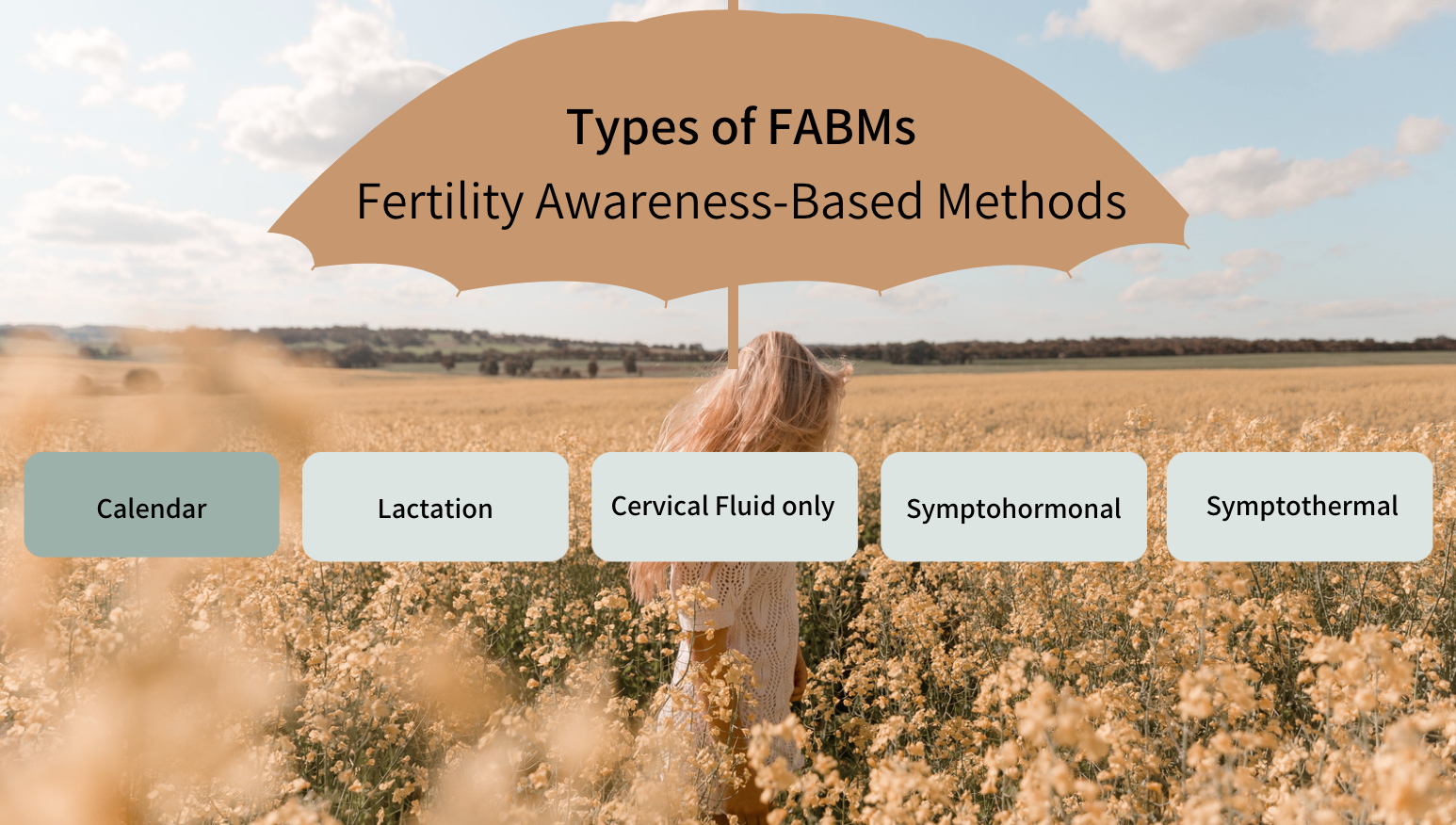
Types of FAM: what are they + how do they work?
Confused about the term fertility awareness, FAM, or FABM?
Continue reading...
The term FAM or fertility awareness can be confusing for many reasons: it’s often a term not used or openly discussed, it’s commonly associated with religious birth control methods, it’s confused with the rhythm method, it’s assumed that only women wanting to get pregnant use it… And the list goes on!
I want to take a little time to clear some things up!
FABM (fertility awareness-based methods)
is the broad umbrella term used to encompass VARIOUS fertility awareness-based methods, hence the acronym.
FABMs are sometimes called Natural Family Planning (NFP), though this term is most often used in a religious setting where abstinence is enforced during the fertile window. FAM is a term often used to describe the secular practice of charting our cycles and often used to refer to just one specific method known as the symptothermal method.
However, it’s important to understand the differences in the various methods because many methods have a bad reputation, particularly when it comes to efficacy for birth control, but also because understanding the differences will allow you to better understand why certain methods might be more effective than others and may help you determine which method would be the best fit for YOU.
I find it helpful to classify the various methods of FABM into 5 types:

- CALENDAR
- LACTATION
- SYMPTOTHERMAL
- SYMPTOHORMONAL
- CERVICAL MUCUS ONLY
It’s important to understand the differences in the various methods because many methods have a bad reputation, particularly when it comes to efficacy for birth control, but also because understanding the differences will allow you to better understand why certain methods might be more effective than others & may help you determine which method would be the best fit for you.
So let’s jump in!
All FABMs work by helping women become aware of their fertile & infertile windows. You are NOT fertile every day! In fact, women are only fertile 6-7 days per cycle.
FABMs are based in this fertile/infertile principle & the more effective forms typically involve daily observation & charting of your body’s biomarkers including: BBT (basal body temperature), CM (cervical mucus or cervical fluid), urinary hormones (LH testing), & cervix positioning.
Women can use these biomarkers to help them more accurately identify their fertile & infertile windows so they can
- Avoid pregnancy
- Achieve pregnancy
- Better understand their hormonal, cervical, vaginal, & overall health
- Live cyclically with their bodies & their hormonal fluctuations
Now that you understand the principles let’s get deeper into terminology.
So again, we start with the broad umbrella term, FABMs, and then we can get more granular into the various methods. I find it helpful to classify the various methods of Fertility Awareness into 5 groups: calendar, lactation, cervical fluid only, symptohormonal, symptothermal
Let’s chat about what the various methods involve...

CALENDAR
- Calendar methods PREDICT the fertile period by using calculations from previous cycles or population averages.
- Many of these tend to use a 28 day cycle, assuming ovulation occurs on day 14 (which is doesn’t for many of us) and then include assumed fertile days around this
- Examples of calendar methods include the Rhythm method, Standard Days method, cycle beads, and most cell phone apps/period trackers
- NOT recommended for natural birth control because of high failure rates!

LACTATION
- Lactation methods are ones used when a woman is lactating or breastfeeding which at times CAN suppress ovulation and therefore fertility.
- Lactation amenorrhea requires 3 things: the woman must be exclusively breastfeeding, have NOT had any bleeding or return of period, & the baby is less than 6 months old.
- Ecological breastfeeding is more of a lactation/breastfeeding lifestyle and includes more strict rules.

CERVICAL FLUID ONLY
- Cervical fluid (CF) is something many of us are not taught, but it's a beautiful + important sign of your cycle health and can be incredibly valuable when you’re trying to understand your fertility, hormones, + inner cycles. CF is a hydrogel made up of 90-98% water & mucin. It is produced in the cervical crypts (which are tiny ridges in your cervix) in response to estrogen & progesterone stimulation. Sensation and quality changes throughout your cycle in response to rising + falling hormones and your underlying fertility.
- CF only methods identify the beginning & end of the fertile window based on cervical fluid observations ONLY
- As a reminder, our cervical fluid changes in response to our underlying hormones and our fertility. So this method is about learning to identify our unique cervical fluid changes that indicate when we are fertile and then we make choices based on our current goals - to get pregnant, avoid pregnancy, etc
- Examples of cervical fluid only method include Billings and Creighton

SYMPTOHORMONAL
- Symptohormonal methods identify the fertile window based on cervical fluid & urinary hormone observations (usually with Clearblue fertility monitor or LH strips or OPKs/ovulation predictor kits)
- So with symptohormonal methods we are looking to identify the start and end of our fertile window by a change in our cervical fluid, then as we approach ovulation we are looking for an LH surge that tells us ovulation is likely impending and then after that we look for another shift in our cervical fluid back to its baseline or infertile pattern.
- Examples of symptohormonal methods include FEMM and Marquette

SYMPTOTHERMAL
- Symptothermal methods identify the fertile window based on basal body temperature & cervical fluid observations, plus optional cervix checks. There are two ways to use the symptothermal method
- Single-check method: includes the above observations, BBT, CF and optional cervix positioning
- Double-check method: adds a calculation rule to the above observations to increase safety/efficacy for those using the method for natural birth control. This calculation is added to the beginning of your cycles and is based solely on your past cycles. Double-check methods are more effective than single-check methods.
- So in the single check symptothermal method we are looking to identify the start of our fertile with our cervical fluid and we look to confirm ovulation with a rise in our basal body temperature and a shift in our CF back to our baseline/infertile pattern
- The double check symptothermal method opens the fertile window with the calculation or CF and closes it with the BBT and CF. So you have two checks on both sides of your fertile window to add to your confidence and observations
- Examples of of the symptothermal method include: my course, the Well, Serena, SymptoPro, Sensiplan, Couple to Couple League, TCOYF, Justisse
Now that you have the details, you may be wondering…
“Does it matter which method I use?”
The best method is the one that works best for you and your partner, if you desire to include them in the process. I do recommend including your partner, if you’re open to it!
Things to consider when choosing a method:
- Efficacy rates
- If you want to use fertility awareness to avoid pregnancy, I highly recommend choosing a method with high efficacy rates, such as the double-check symptothermal method ,and learning with an instructor for at least the first 3 cycles. This ensures you thoroughly understand the method & have support in the process
- It’s common to hear about the 99.6% effectiveness rate of FABMS, but as you now know, not all FABMs are created equal! This high efficacy rating is based on a study of the Sensiplan Method which is a Double-check Symptothermal Method. Make sure the you are clear on the efficacy of what you are choosing if this matters to you. I’ve included a few resources at the bottom to help.
- Your learning style
- Do you prefer online or in-person learning?
- Do you do do better in a group setting or with one-on-one work?
- Do you prefer largely self-study work or do you do better with accountability & more consistent access to ask questions
- Secular vs Religious teachings
- Most methods are offered in various settings. Choose a class/instruction that will be respectful of your beliefs & needs.
- Your stage of life and lifestyle & health issues
- Different methods might be more fitting for different health issues, lifestyles, or stages of life. If you are unsure what method to choose or if you are wanting to learn a certain method but want to better understand if it is a good fit for you, discussing your situation with an educator (or a few educators) before you choose a method can be extremely helpful.
- Examples of how your unique circumstance might affect your method choice: Women who are postpartum or those with confusing cervical mucus patterns might benefit from Symptohormonal methods while women with PCOS may want to avoid these methods. Or, those with insomnia or erratic schedules (night shift workers, postpartum moms) might have more challenges using the Symptothermal method - though TempDrop is a wonderful resource for this! I have struggled intermittently with insomnia but wanted to use the symptothermal double-check method because it has the highest efficacy rating - TempDrop has made this journey so much easier.
What do I teach and why?
I teach the Double-Check Symptothermal method because I wanted a method for myself and other women that is highly effective, based on scientific studies. I also include holistic hormonal health education because I believe education should also teach us HOW to support our charts, cycles, and hormones. In private work I also integrate LH testing (when appropriate) and make specific recommendations for diet, lifestyle, herbs, supplements, and mind-body practices that will address the individual clients unique body, health status, + desires. You don’t fit a mould, why should your FAM education?
Okay loves.. that’s it, that’s all!
I hope this information was valuable! If you feel called to learn more about the symptothermal method I invite you to look into more of my FAM self-study and private offerings! Or if you need help picking an offering that is perfect for you, please set up a complimentary 30 minute clarity call to discuss things further.
with love,
Dr. Mona
P.S. Below are some resources to help you better understand the effectiveness of the various Fertility Awareness-Based Methods:
- My comprehensive FAM course
- Effectiveness of Fertility Awareness-Based Methods for Pregnancy Prevention: A Systematic Review, 2018
- Lactational amenorrhoea method for family planning, 2015
- Fertility awareness-based methods of family planning: A review of effectiveness for avoiding pregnancy using SORT, 2013
- Natural Family Planning, 2012
- Fertility Awareness-Based Methods: Another Option for Family Planning, 2009




